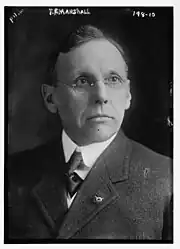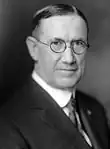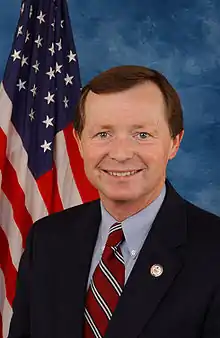North Dakota's at-large congressional district
North Dakota's at-large congressional district is the sole congressional district for the state of North Dakota. Based on size, it is the eighth largest congressional district in the nation.
| North Dakota's at-large congressional district | |||
|---|---|---|---|
 | |||
| Representative |
| ||
| Area | 68,976 sq mi (178,650 km2) | ||
| Distribution |
| ||
| Population (2022) | 779,261[1] | ||
| Median household income | $71,970[2] | ||
| Ethnicity |
| ||
| Cook PVI | R+20[3] | ||
The district is currently represented by Kelly Armstrong.
History
The district was first created when North Dakota achieved statehood on November 2, 1889, electing a single member. Following the 1900 United States census the state was allocated two seats, both of whom were elected from an at large district. Following the 1910 United States census a third seat was gained, with the legislature drawing three separate districts. The third district was eliminated after the 1930 United States census. After the third seat was lost, North Dakota returned to electing two members at-large (statewide).
Following the 1960 United States census two separate districts were created. In 1970, the second district was eliminated following the 1970 United States census and a single at-large district was created. Since 1972, North Dakota has retained a single congressional district.
List of members representing the district
1889–1913: one seat, then two
From 1889 to 1903, there was one seat, elected at-large statewide. In 1903 a second at-large seat was added, lasting until 1913.
| Dates | Cong ress |
Member at-large | Member at-large | |||||
|---|---|---|---|---|---|---|---|---|
| Member | Party | Electoral history | Member | Party | Electoral history | |||
| March 4, 1889 – November 1, 1889 |
51st | First member seated on November 2, 1889 | Second seat added in 1903 | |||||
| November 2, 1889 – March 3, 1891 |
 Henry C. Hansbrough (Devils Lake) |
Republican | Elected in 1889. Lost renomination. | |||||
| March 4, 1891 – March 3, 1899 |
52nd 53rd 54th 55th |
 Martin N. Johnson (Petersburg) |
Republican | Elected in 1890. Re-elected in 1892. Re-elected in 1894. Re-elected in 1896. Retired to run for U.S. Senator. | ||||
| March 4, 1899 – March 3, 1901 |
56th |  Burleigh F. Spalding (Fargo) |
Republican | Elected in 1898. Retired. | ||||
| March 4, 1901 – March 3, 1903 |
57th |  Thomas F. Marshall (Oakes) |
Republican | Elected in 1900. Re-elected in 1902. Re-elected in 1904. Re-elected in 1906. Retired to run for U.S. Senator. | ||||
| March 4, 1903 – March 3, 1905 |
58th |  Burleigh F. Spalding (Fargo) |
Republican | Elected in 1902. Lost renomination. | ||||
| March 4, 1905 – March 3, 1909 |
59th 60th |
 Asle Gronna (Lakota) |
Republican | Elected in 1904. Re-elected in 1906. Re-elected in 1908. Resigned after elected U.S. Senator. | ||||
| March 4, 1909 – February 11, 1911 |
61st |  Louis B. Hanna (Fargo) |
Republican | Elected in 1908. Re-elected in 1910. Resigned when elected Governor of North Dakota. | ||||
| February 11, 1911 – March 3, 1911 |
Vacant | |||||||
| March 4, 1911 – January 7, 1913 |
62nd |  Henry T. Helgesen (Milton) |
Republican | Elected in 1910. Redistricted to the 1st district. | ||||
| January 7, 1913 – March 3, 1913 |
Vacant | |||||||
1913–1933: districts only
After the 1910 census, three seats were apportioned among districts: the 1st district, 2nd district, and 3rd district.
1933–1963: two seats
In 1933, following the 1930 census, the delegation was reduced to two seats and the districts were eliminated in favor of a pair of at-large districts, lasting until 1963.
1963–1973: districts again
In 1963, following the 1960 census, the delegation was again split between geographic districts, the 1st district and 2nd district.
1973–present: one seat
In 1973, following the 1970 census, the delegation was reduced to one seat, represented statewide by an at-large district.
Recent statewide results
| Year | Results | Party |
|---|---|---|
| 2000 | George W. Bush 61% – Al Gore 33% | Republican |
| 2004 | George W. Bush 63% – John Kerry 36% | Republican |
| 2008 | John McCain 53% – Barack Obama 45% | Republican |
| 2012 | Mitt Romney 59% – Barack Obama 39% | Republican |
| 2016 | Donald Trump 64% – Hillary Clinton 28% | Republican |
| 2020 | Donald Trump 66% – Joe Biden 32% | Republican |
Electoral history
2006
| Party | Candidate | Votes | % | ±% | |
|---|---|---|---|---|---|
| Democratic–NPL | Earl Pomeroy (Incumbent) | 142,934 | 65.68% | +6.11% | |
| Republican | Matt Mechtel | 74,687 | 34.32% | −6.11% | |
| Democratic–NPL hold | Swing | ||||
| Turnout | 217,621 | ||||
2008
| Party | Candidate | Votes | % | ±% | |
|---|---|---|---|---|---|
| Democratic–NPL | Earl Pomeroy (Incumbent) | 194,577 | 61.97% | -3.71% | |
| Republican | Duane Sand | 119,388 | 38.03% | +3.71% | |
| Democratic–NPL hold | Swing | ||||
| Turnout | 313,965 | ||||
2010
| Party | Candidate | Votes | % | ±% | |
|---|---|---|---|---|---|
| Republican | Rick Berg | 129,802 | 54.74% | +16.71% | |
| Democratic–NPL | Earl Pomeroy (Incumbent) | 106,542 | 44.93% | −17.04% | |
| Independent | Write-In Votes | 793 | 0.33% | ||
| Republican gain from Democratic–NPL | Swing | ||||
| Turnout | 237,137 | ||||
2012
| Party | Candidate | Votes | % | ±% | |
|---|---|---|---|---|---|
| Republican | Kevin Cramer | 173,585 | 54.89% | +0.15% | |
| Democratic–NPL | Pam Gulleson | 131,870 | 41.70% | −3.23% | |
| Libertarian | Eric Olson | 10,261 | 3.24% | +3.24% | |
| Independent | Write-In Votes | 508 | 0.16% | ||
| Republican hold | Swing | ||||
| Turnout | 316,224 | ||||
2014
| Party | Candidate | Votes | % | ±% | |
|---|---|---|---|---|---|
| Republican | Kevin Cramer (Incumbent) | 138,100 | 55.54% | +0.65% | |
| Democratic–NPL | George B. Sinner | 95,678 | 38.48% | −3.22% | |
| Libertarian | Robert J. "Jack" Seaman | 14,531 | 5.84% | +2.6% | |
| Independent | Write-In Votes | 361 | 0.15% | ||
| Republican hold | Swing | ||||
| Turnout | 248,670 | ||||
2016
| Party | Candidate | Votes | % | ±% | |
|---|---|---|---|---|---|
| Republican | Kevin Cramer (Incumbent) | 233,980 | 69.13% | +13.59% | |
| Democratic–NPL | Chase Iron Eyes | 80,377 | 23.75% | −14.73% | |
| Libertarian | Robert J. "Jack" Seaman | 23,528 | 6.95% | +1.11% | |
| Independent | Write-In Votes | 574 | 0.17% | ||
| Republican hold | Swing | ||||
| Turnout | 338,459 | ||||
2018
| Party | Candidate | Votes | % | ±% | |
|---|---|---|---|---|---|
| Republican | Kelly Armstrong | 193,568 | 60.20% | -8.93% | |
| Democratic–NPL | Mac Schneider | 114,377 | 35.57% | +11.82% | |
| Independent | Charles Tuttle | 13,066 | 4.06% | ||
| n/a | Write-ins | 521 | 0.16% | ||
| Total votes | 321,532 | 100.00% | |||
| Republican hold | |||||
2020
| Party | Candidate | Votes | % | ±% | |
|---|---|---|---|---|---|
| Republican | Kelly Armstrong (incumbent) | 245,229 | 68.96% | +8.76% | |
| Democratic–NPL | Zach Raknerud | 97,970 | 27.55% | -8.02% | |
| Libertarian | Steven Peterson | 12,024 | 3.38% | New | |
| n/a | Write-ins | 375 | 0.11% | -0.15% | |
| Total votes | 355,595 | 100.0% | |||
| Republican hold | |||||
2022
| Party | Candidate | Votes | % | ±% | |
|---|---|---|---|---|---|
| Republican | Kelly Armstrong (incumbent) | 148,399 | 62.20% | –6.76 | |
| Independent | Cara Mund | 89,644 | 37.57% | N/A | |
| Write-in | 543 | 0.23% | +0.12 | ||
| Total votes | 238,586 | 100.00% | |||
| Republican hold | |||||
References
- "My Congressional District".
- "My Congressional District".
- "2022 Cook PVI: District Map and List". The Cook Political Report. July 12, 2022. Retrieved January 7, 2023.
- John Lengenfelder described himself as "Academic Christian Freedom, Prolife-Family" when filing for election.
- Johnson, Cheryl L. (February 28, 2019). "Statistics of the Congressional Election of November 6, 2018". Clerk of the U.S. House of Representatives. Retrieved April 27, 2019.
- Election statistics compiled by the Clerk to the House of Representatives; Michael J. Dubin, "United States Congressional Elections 1788-1997" (McFarland, 1998).
- Martis, Kenneth C. (1989). The Historical Atlas of Political Parties in the United States Congress. New York: Macmillan Publishing Company.
- Martis, Kenneth C. (1982). The Historical Atlas of United States Congressional Districts. New York: Macmillan Publishing Company.
- Congressional Biographical Directory of the United States 1774–present











.jpg.webp)
